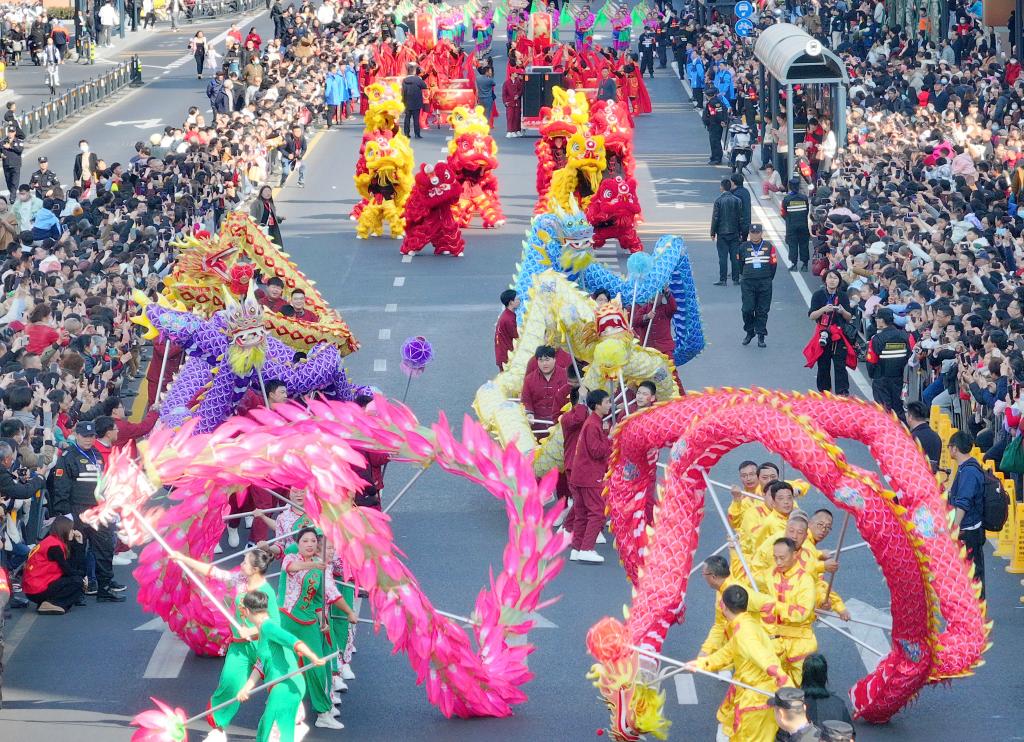


An aerial drone photo taken on Feb. 14, 2024 shows tourists watching a folk art parade in Chongchuan District of Nantong City, east China's Jiangsu Province. More Chinese people nowadays choose to go on a journey during the Spring Festival to experience different cultures and lunar new year atmosphere. (Photo by Xu Congjun/Xinhua)
BEIJING, Feb. 17 (Xinhua) -- For the Chinese people, the eternal theme of the Spring Festival, or Chinese New Year, remains family reunion, yet an increasing number of Chinese are choosing to integrate travel into their holiday traditions.
The change was seen this year as the Spring Festival holiday spanned eight days -- possibly nine with a flexible one-day paid leave -- surpassing the usual one-week holiday in previous years.
According to data released Saturday by Chinese travel website Mafengwo, Monday and Tuesday saw peak travel activity.
"We made a random decision to drive to the historic city of Datong (in northern China) on Monday but were surprised to see a large number of tourists. Local hotel chains are almost always full, and restaurants almost always have a waiting line," said a tourist surnamed Li.
NEW TRENDS IN DOMESTIC TOURISM
According to Mafengwo, family travel accounted for 45 percent of all trips during the holiday, reflecting a trend that young people return home for family reunions before embarking on trips with their families, taking advantage of the extended holiday period.
Beijing, Xi'an and the Guangdong-Hong Kong-Macao Greater Bay Area were among the most popular tourist destinations, said Mafengwo, adding that visiting museums, grottoes, temples and other historical and cultural places was another highlight of this year's Spring Festival travel after temple fairs and folk activities.
A report by travel portal Tuniu.com showed an emerging trend for cross-regional travel between the northern and southern parts of the country during the holiday.
Harbin, capital of northeastern Heilongjiang Province, maintained its growing popularity among people from the South who are eager to explore an ice-and-snow world, while tropical cities such as Sanya, Xishuangbanna, and Beihai remained favored destinations for northlanders seeking winter getaways.
SURGING OUTBOUND TOURISM
Data from multiple online travel platforms showed that on the first day of the eight-day holiday, outbound travel bookings already surpassed the 2019 figure, with Southeast Asian countries, particularly those with visa-free policies for Chinese nationals, emerging as red-hot destinations.
From Feb. 10 to 13, bookings for hotels in Bangkok tripled year on year, while reservations for Singaporean hotels reported a stunning growth of 800 percent, according to the travel platform LY.com.
Several European destinations have introduced unique strategies to attract Chinese tourists. A Michelin-starred restaurant in downtown London has launched a menu specially designed for the Year of the Loong (Dragon), while a railway for the well-known scenic spot Jungfrau in Switzerland has been decorated with Chinese elements to greet Chinese tourists between Feb. 8 and 20.
With a substantial rise in outbound tourism, this holiday is projected to see a daily port clearance of 1.8 million people nationwide, more than triple that of the previous year and nearly reaching the level of 2019, according to the National Immigration Administration.
According to a market forecast by Ctrip, a leading travel platform in China, the eight-day holiday would mark the country's first travel rush of the year, with a notable increase in international travel being one of the highlights.
"Destinations in Southeast Asia have continued to gain traction as many in China opted for the region for an escape from the winter season," said Gao Tao, from Tuniu. "The tourism industry has gone through a rough patch in the past three years due to the pandemic. But it is now poised for a growth spurt, particularly in outbound tourism."
In 2023, China saw its outbound passenger trips exceed 87 million, and this figure is projected to reach 130 million in 2024, according to a paper published by the China Tourism Academy.
点击右上角![]() 微信好友
微信好友
 朋友圈
朋友圈

请使用浏览器分享功能进行分享
